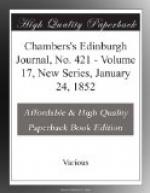But another and a very different argument has been adduced, not certainly for the re-establishment and support of a sinking-fund, since its fallacy has been exposed, but against the policy of having exposed it. It is said that the belief in the potency of a sinking-fund for clearing off the debt inspired public confidence in the stability of the funds, and that it was wrong to shake this confidence even by the promulgation of truth. It has often been supposed, indeed, that the statesmen who mainly carried out the system were in secret conscious of its fallacy, but were content to carry it out so long as they saw that it inspired confidence in the public. It is in allusion to this that we have spoken of the sinking-fund as a great hoax. We cannot sanction the morality of governments acting on conscious fallacies; and in this instance the natural confidence in the funds rather enlarged than decreased when the fallacy was exposed and the system abandoned.
Keeping in view Dr Price’s views of the potentiality of compound interest, we now give a brief account of a singular attempt made in France to put them in practice, and by their omnipotence pay our national debt and that of other nations too, out of a small private fortune. In the year 1794, a will was registered in France by one Fortune Ricard, disposing of a sum of 500 livres, a little more than L.20 sterling. Fortune stated that this sum was the result of a present of twenty-four livres which he had received when he was a boy, and had kept accumulating at compound interest to a period of advanced age. By his will he left it in the hands of trustees, making arrangements for a perpetual succession, as the purposes of the trust were not to be all accomplished for a period of several centuries. The money was to be divided into five portions, each of 100 livres, and so to be put out at compound interest.
The first portion was to be withdrawn at the end of a century: it would then amount to 13,000 livres, or about L.550. It is scarcely worth while mentioning the purposes to which this trifle was to be applied, but for the credit of M. Ricard it may be mentioned that they were all unexceptionable. In two centuries the second sum would be released, amounting to 1,700,000 livres. At the end of the third century, the third instalment was to be released, when it would consist of 226,000,000 livres. The destination of these magnificent sums was also unexceptionable—it was for national education, the erecting of public libraries, and the like. The instalment to be released at the end of the fourth century would amount to about 30,000,000,000 livres: it was to be employed partly in the building of 100 towns, each containing 150,000 inhabitants, in the most agreeable parts of France. ‘In a short time,’ says the benevolent founder, ’there will result from hence an addition of 15,000,000 of inhabitants to the kingdom, and its consumption will be doubled—for which service I hope the economists will think themselves obliged to me.’ Malthus had not then published his principles of population.




